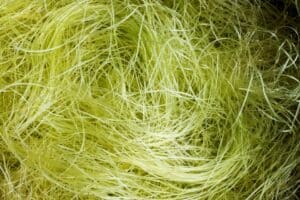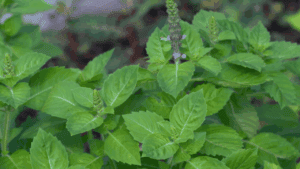Agrimony is the herb of paradox. On the one hand, it’s described as a relaxant,and on the other hand, as an astringent. How does it contract and relax a tissue at the same time?! What do you do when you find conflicting information surrounding the herb you’re studying?
Although these two aspects of Agrimony may seem contradictory at first, there’s a way that you can study the herb that connects them to form a larger whole. By learning how to study herbs in this way, you gain the skillset to understand complex plants on a deeper level that unites their disparate parts to form a whole.
In today’s plant profile, you’ll discover:
- Agrimony’s paradoxical nature and how to understand its relaxant and astringent properties
- How Agrimony supports nerve innervation for improved digestion and urinary tract health.
- Ways that Agrimony flower essence helps you embrace your true emotions and let go of the mask
- Agrimony’s connection to planet Mercury and how it lowers tension
- How Agrimony aligns with the Earth Element because of its astringency and balances your inner Earth
Table of Contents
Have you ever come across an herb that piqued your interest, only to be baffled by conflicting information when you started researching it? One book claims it has warming properties, while another insists it’s cooling. Some sources label it a relaxant, while others insist it’s astringent. I know how frustrating and confusing this can be, as I’ve experienced it myself many times. Over time, I’ve learned how to integrate these seemingly conflicting pieces of information to form a larger holistic picture of the plant. Through this approach, I’ve gained a deeper understanding of how the herb works–even in seemingly contradictory ways.
Agrimony is a fascinating plant that embodies paradoxical characteristics, yet forms a harmonious whole. At first glance, Agrimony is tense and astringent. While it increases tension in overly lax tissues, it also has the incredible ability to relax tension in the body. Confusing, right?
Although it can take time to understand the paradoxical nature of Agrimony, you gain a deeper appreciation for its holistic applications by studying its various parts. Agrimony is an old remedy used in European herbalism for centuries and offers numerous applications that are highly relevant to common ailments faced by many people today. By acknowledging and embracing the paradoxical nature of Agrimony, we gain a deeper appreciation for its herbal applications and profound healing potential.
Common name: Agrimony
Latin name: Agrimonia eupatoria
Family: Rosaceae
Part Used: Leaf
Tastes: Astringent, Bitter, Acrid
Affinities: Mucosal membranes, Digestive, Liver and Gallbladder, Urinary Tract, Nervous System, Female Reproductive System
Actions: Astringent, Nervine Relaxant, Bitter Tonic, Kidney Tonic, Nervine
Energetics: Cooling, Drying, Relaxant

Taste
Agrimony is a fascinating herb with surprising connections to the Rose family. The main part used is the leaf, though some traditions also utilize the root. If you’ve ever tasted plants from the Rose family, you’ll notice a familiar astringent taste in Agrimony like many of its fellow Rosaceae relatives.
This herb is packed with tannins, which work wonders in tightening the mucosa throughout your gastrointestinal tract. When you consume Agrimony, you might notice your mouth puckering up—a unique sensation caused by its tannin-rich nature. Before Agrimony blooms, it carries a touch of bitterness, which then evolves into a slightly acrid flavor. Some herbalists claim it has a sweet note, but I primarily perceive it as bitter and astringent.
Affinities
Diving into its primary organ affinities, Agrimony is a versatile herb with numerous affinities. However, its primary focus lies in the mucosal membranes, where its astringency tightens and binds the mucosal membrane. This effect extends throughout the organs, showcasing its true adaptability.
When it comes to the digestive system, Agrimony has a rich history of treating digestive issues where an astringent is needed, such as with a leaky gut. For this purpose, I like to combine it with other astringents, like Calendula and Plantain. This trio works harmoniously with bitters, carminatives, and demulcents for a full spectrum effect, such as Dandelion root (Taraxacum officinale), Fennel (Foeniculum vulgare), and Marshmallow (Althaea officinalis).
Agrimony’s bitter flavor also indicates a special affinity for the liver and gallbladder, aligning it with many other yellow-colored plants with a hepatobiliary affinity, such as Oregon Grape (Mahonia aquifolium) and Goldenseal (Hydrastis canadensis). This herb’s influence extends into the urinary tract, where it’s been traditionally used for various leaky urinary tract issues and kidney restoration.
Another prime affinity for Agrimony is its unique connection to the nervous system. Unlike typical nervine relaxants, like Skullcap or Lavender, Agrimony focuses on innervating both the nervous system and other organs. When nervous tension affects other organ systems, Agrimony is a great choice.
The herb itself portrays a sense of tension, evident in its appearance with sharply serrated leaf margins and an overall taut look. The Agrimony person often exhibits tension, making it easier to identify when this herb can be beneficial. Incorporating Agrimony in nervine formulas alongside classic relaxants like Lavender (Lavandula angustifolia) and Skullcap (Scutellaria lateriflora) can help ease physical tension associated with that nerve innervation.
While some herbalists mention its effects on the female reproductive system, I feel that it’s perhaps more of a secondary influence. To me, Agrimony’s primary affinities lie in the gastrointestinal, liver, gallbladder, nervous, kidney, and urinary systems. In each of these systems, Agrimony regulates tension by increasing tone where laxity and relaxing nervous constriction afflict these systems.
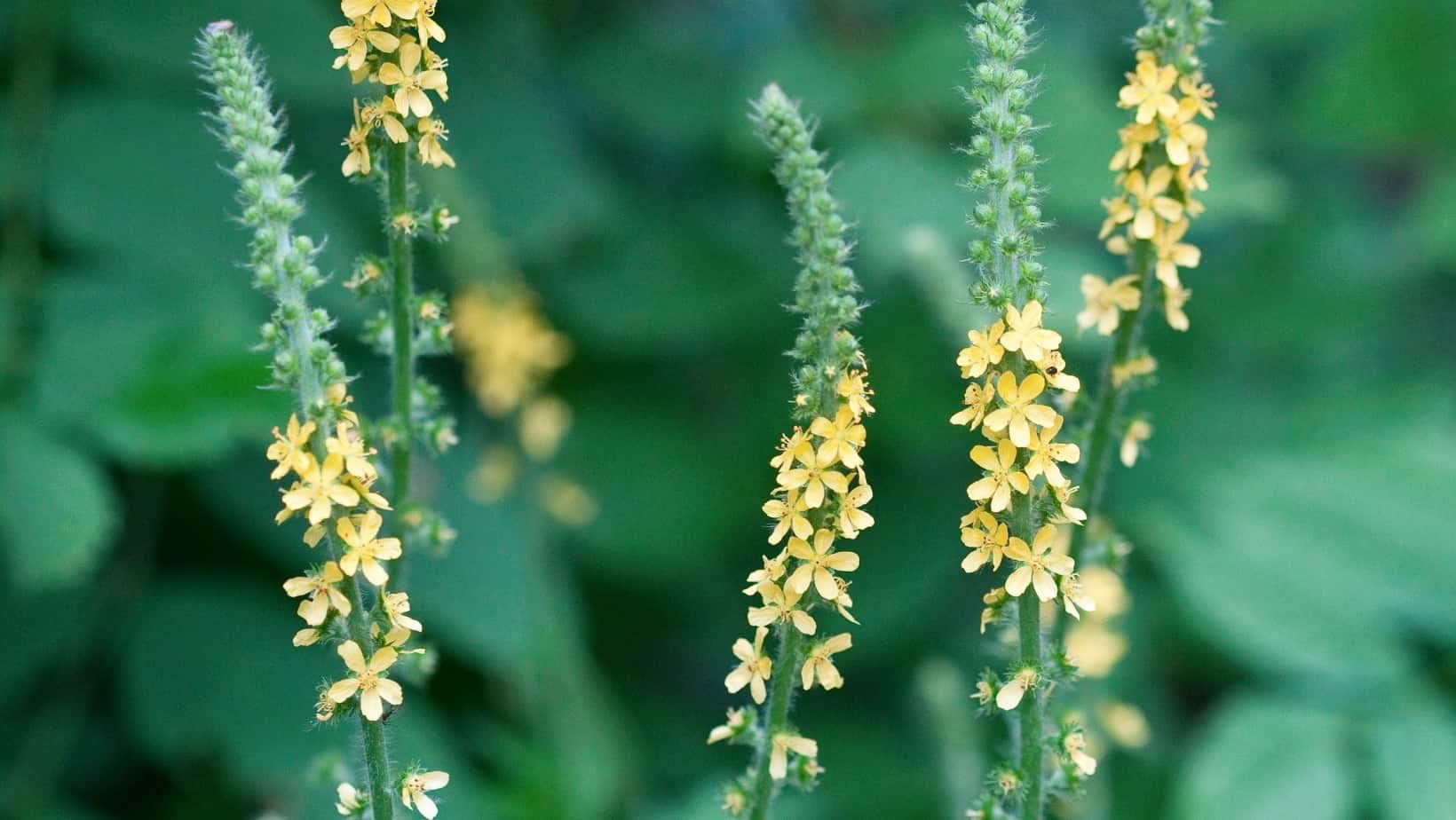
Actions
In regards to its herbal actions, Agrimony takes center stage as an outstanding tonic. But before diving into this action, let’s clarify what this word means. Tonic can mean different things in various traditional practices. In Western herbalism, a tonic herb binds and tightens loose and lax tissues to improve their healthy functioning. However, in Chinese medicine, it holds an entirely different meaning.
In the context of Western herbalism, you can consider Agrimony anytime you need to increase the tonal quality of the tissue. In the digestive system, this can be leaky gut, loose stools, and diarrhea. With its high tannin content, Agrimony astringes the gut lining to reduce excessive permeability. Agrimony is also a bitter tonic, which increases gastric secretions to improve digestion and nutrient assimilation. Lastly, Agrimony eases gastrointestinal spasms because it works on nerve innervation as a nervine relaxant.
Agrimony’s nervine relaxant property acts on the nervous innervation of the digestive system, bladder, and hepatic artery, and it’s an excellent herb to consider whenever tension affects these areas. Agrimony’s paradoxical nature might leave you intrigued. On the one hand, it acts as a relaxant for spasms, and on the other, as an astringent for laxity. So, how do we make sense of this paradox?
One way I make sense of this is by seeing that Agrimony’s tonic and relaxant properties work on two different parts of the body. While its astringency tightens and tones lax tissue linings and mucosal membranes, its nervine relaxant eases pain and spasms in the nerves and muscles. In the example of digestive complaints, Agrimony astringes the tissues when there’s excess laxity, like loose stools and leaky gut syndrome, while simultaneously working on that nerve innervation to lessen tension and pain.
Shifting into the hepatobiliary system, Agrimony shines when there’s bile insufficiency. Its bitter tonic action encourages the movement of bile and improves liver functioning. This herb has been classically used to treat hepatitis and cirrhosis and combines well with liver trophorestorative herbs such as Milk Thistle (Silybum marianum), Artichoke (Cynara scolymus), Schisandra berry (Schisandra chinensis), and Reishi (Ganoderma lucidum) for optimal results.
Unlike many organs in the body, such as the blood vessels and intestines, the liver is not directly innervated by the nervous system. This means that a tense nervous system won’t lead to a tense liver because there isn’t any smooth muscle that surrounds it that could cause it to spasm. That said, the nervous system indirectly affects the liver by controlling its arterial blood supply through the hepatic artery. Under stress, the nervous system directs the blood flow away from the core and out to the periphery to prepare you for fight, flight, or freeze. As sympathetic dominance persists and the liver is deprived of the fresh oxygenated blood it needs to manage the toxin load placed on it, liver stagnation develops. Agrimony remedies this pattern by calming sympathetic excess as a nervine relaxant and promoting healthy blood flow to the liver as a bitter tonic and by dilating the hepatic artery to give it more fresh arterial blood.
Agrimony doesn’t only benefit the anatomical liver discussed in Western herbalism, but the Liver system in Chinese medicine as well. In this system, the Liver’s primary function is to maintain the even distribution of chi or the vital force throughout the body. A common pattern many face today is liver chi stagnation, which can lead to tension, emotional distress, and headaches. Some herbalists believe Agrimony can address liver chi stagnation by easing constriction in the vital force, allowing it to flow more evenly throughout the system. This makes Agrimony beneficial for liver-associated tension headaches.
Agrimony is a classic remedy for the urinary tract because of its astringent action. By tonifying a weak bladder and working on the bladder nerve, it’s used for the passive leakage of urine, such as incontinence, dribbling, and bedwetting for children, adults, and the elderly. Its ability to reduce tension makes it particularly helpful for children transitioning from diapers to using the bathroom independently since that experience can feel tense and stressful for small children. Because Agrimony works on nerve innervation, it tones the bladder nerve and tissues to prevent and reduce leakage. This herb is an important remedy here, and I consider it anytime passive relaxation in the kidneys and urinary tract impact functioning.
Some herbalists consider Agrimony a kidney tonic and trophorestorative and use it to support kidney health. To enhance its trophorestorative action, it combines well with Nettle seed (Urtica diocia) and Astragalus (Astragalus membranaceous) root. It’s also used for more serious kidney pathology, like kidney stones, to relieve some of the pain after the passage of a stone. Despite this traditional usage, it’s important to always consult a primary care physician for serious kidney conditions.
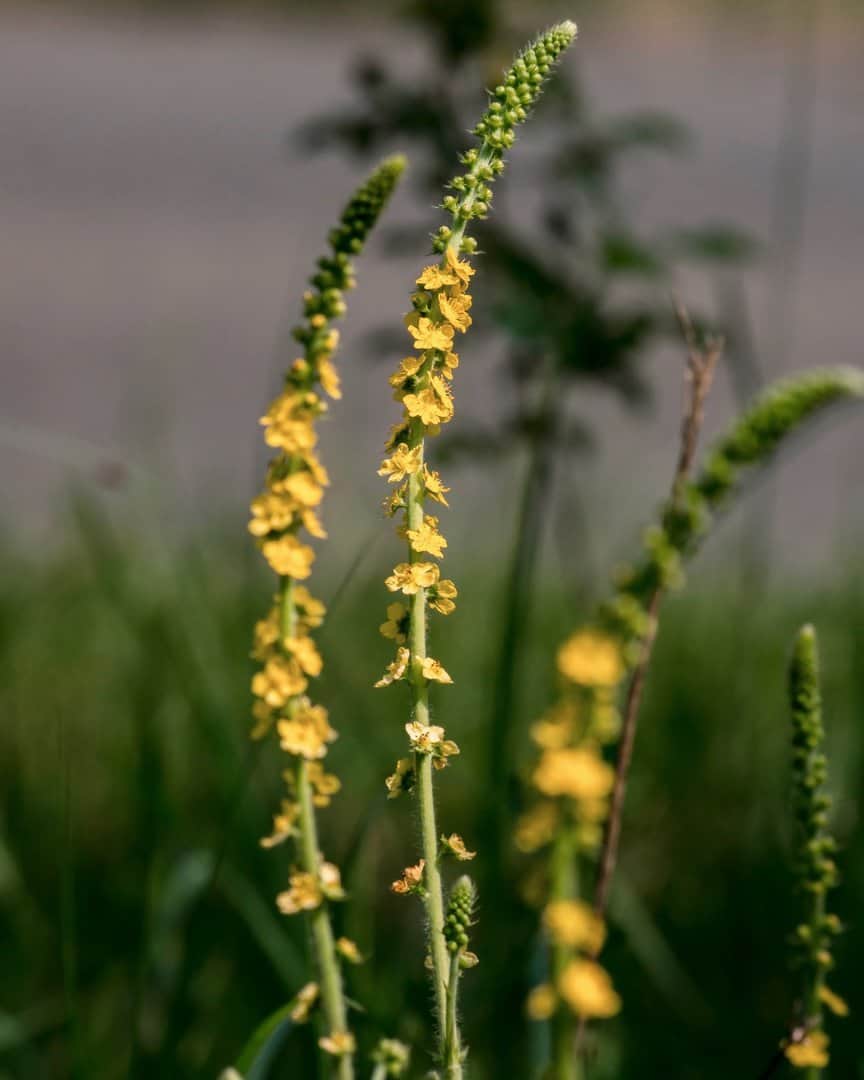
Energetics
Agrimony, like many plants in the Rose family, is energetically cooling because of its bitter tonic and inflammatory-modulating properties. Its astringent action aids in drying excess fluids, lending it an energetically drying quality. Within the nervous innervation, Agrimony acts as a relaxant, while within the mucosal membranes, it serves as an astringent and tonic.
The versatility of this herb makes it applicable for several different tissue states, including damp/relaxation (as an astringent), wind/tension (as a relaxant), and heat/excitation (as a cooling sedative). For damp/relaxation, Agrimony restores the structural integrity to mucosal membranes and organs that have become too lax, flabby, and lost their tone. In balancing wind/tension, Agrimony eases excess tension in the nervous system. Because it’s cooling, Agrimony reduces hyperactivity in heat/excitation.
From an ayurvedic perspective, Agrimony’s astringency and drying properties make it an excellent remedy for kapha, who tends to be lax and damp. It can also benefit pitta because of its cooling energetics. Agrimony aggravates vata dosha, which is naturally tense and dry.
Psychological and Emotional Aspects
Agrimony is one of the original flower essences pioneered by Dr. Bach. Agrimony is well-known for its ability to help people who may appear to be happy and successful on the outside, but are struggling emotionally on the inside. Matthew Wood describes this personality as “torturedly cheerful,” where a big smile masks inner turmoil and emotional distress.
According to the Bach center, Agrimony “…is the remedy for people who keep their troubles hidden under a mask of pleasure and happiness. The sad clown masking inner hurt by being the life and soul of the party is an Agrimony archetype. Friends are often the last to know that anything is wrong in the Agrimony person’s life. Sometimes Agrimony people turn to drink or drugs to help them stay ‘happy’. They tend not to like being alone: the mask slips when there is no company. They seek out friends, parties and bright lights. Only at night when they are alone with their thoughts will the mental torture they have repressed come back to haunt them. Agrimony helps us come to terms with the darker side of our lives and personalities, so that we can become more rounded human beings. We won’t lose our sense of humor or our ability to get through the day, but will find that laughing at our troubles dispels them rather than hides them. As a mood remedy, Agrimony helps anyone who is trying not to face trouble and using jokes and false smiles to avoid a painful reality.”
The Agrimony person often feels like a taut wire or an inflated balloon about to burst because it takes a significant amount of energy to maintain the facade while struggling inside. Agrimony flower essence can help them release this tension, allowing them to be their true selves without the burden of pretense. Agrimony is also beneficial for those who unconsciously hold their breath during emotional or physical pain. This essence can offer support to individuals experiencing discomfort from kidney stones, gallstones, or emotional sources, helping them to let go of tension and breathe freely.

Alchemical Correspondences
In the realm of energetic architecture, Agrimony’s unique properties are linked to the planet Mercury, which governs tension—an aspect directly influenced by Agrimony. My teacher, Judith Hill, my teacher in medical astrology, emphasized Mercury, along with its higher planetary octave, Uranus, as the planets associated with tension. When these planets afflict an individual’s astrological chart, it can lead to stress, nervousness, anxiety, spasms, and constriction. As Agrimony works on the nerves and their innervation throughout the body, it plays a vital role in addressing imbalances of tension in the mind and body. I also see the paradoxical aspect of Agrimony as mercurial because Mercury is the planet that bridges polarities and sits right in the middle of opposing qualities and energies.
Considering its elemental attributes, Agrimony aligns with the Earth Element, because of its remarkable astringent qualities which firm and strengthen structural walls within the body. Astringents are utilized for relaxed tissue states where the Earth Element lacks the ability to hold in the Water Element or fluids. This deficiency causes an excess of fluids to leak or flow passively in places where they shouldn’t, whether internally within the body or outside. Agrimony fortifies the Earth Element by tightening, binding, and contracting physical tissues. This action allows tissues to better contain fluids, maintain balance, and improve stability.

Growing Agrimony
Agrimony is relatively easy to grow from seed, and there are two primary methods you can follow for germinating them. For the first option, you can sow them directly. The best time to sow your seeds is in the fall, where they’ll remain dormant until the arrival of spring and after the last frost. Having this period of cold weather is essential for the seeds to germinate successfully.
If you prefer to sow indoors, you can begin the germination process approximately 8 weeks before the last process. To mimic the necessary cold winter weather, sow the seeds about a quarter inch deep into a container with pre-moistened soil. Place your container in a plastic bag to retain moisture and store it in the refrigerator for a month. After the cold stratification period is complete, remove your container from the bag and place it on a sunny windowsill and wait for germination to occur, which typically takes around 10-14 days. After the last frost, transplant your seedlings into your garden spacing them roughly 3 feet apart for optimal growth. By following these simple stamps, you can enjoy the beauty and herbal benefits of Agrimony in your garden.
Preparation
I prefer to harvest Agrimony leaf just before it flowers because that’s when some of its other tastes are present, such as its bitterness and acridity. If you wait until Agrimony flowers, it will be predominantly astringent.
I prefer Agrimony as a fresh tincture, done at a mid-range alcohol percentage, around 50-60% depending on how moist the plant material is. Dried plant materia can be extracted at 35-40% alcohol to get the most balanced preparation that includes astringency, bitterness, and acridity. 1:5 ratio for dried plants, 1:2 for fresh.
At first glance, Agrimony has conflicting and confusing applications. However, by acknowledging, embracing, and learning how to understand the paradoxical nature of Agrimony, we gain a deeper appreciation for its holistic approach to healing.
The next time you encounter conflicting information about an herb, remember that it’s through fusing together the seemingly opposing traits that youl uncover a more profound understanding of its true potential.
Agrimony may initially appear to be a riddle wrapped in an enigma, but with patient exploration and an open mind, you can learn how to see it for its holistic applications. As you delve into the world of herbalism, let Agrimony be a shining example of the beauty that lies in embracing nature’s complexity and seeing the wholeness within.
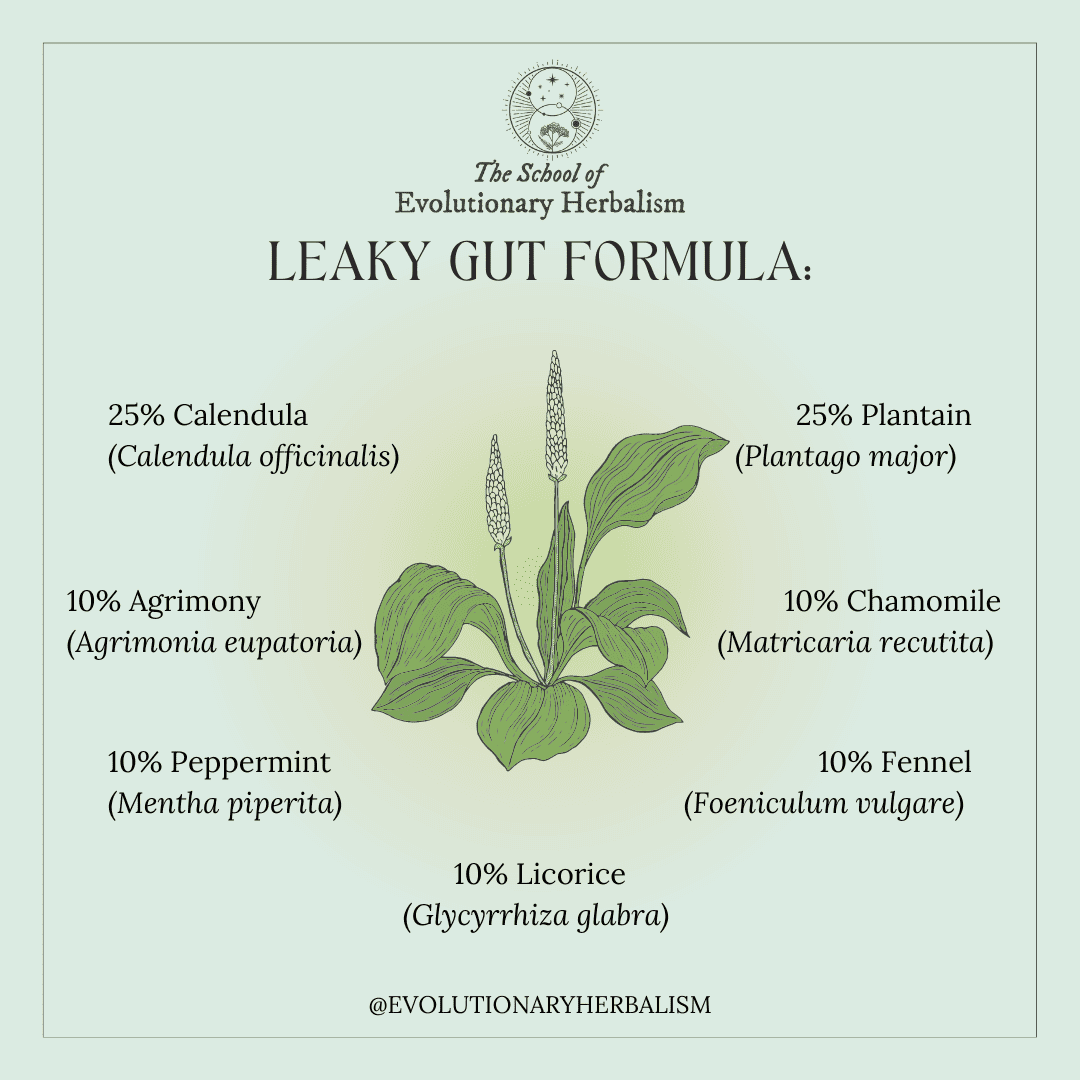
Leaky Gut Formula
25% Plantain (Plantago major)
25% Calendula (Calendula officinalis)
10% Agrimony (Agrimonia eupatoria)
10% Chamomile (Matricaria recutita)
10% Peppermint (Mentha piperita)
10% Fennel (Foeniculum vulgare)
10% Licorice (Glycyrrhiza glabra)
In this digestive formula, Calendula, Plantain, and Agrimony provide structure to the mucosal membranes with their astringent property while also relaxing liver tension, which can occur when an excess of metabolic products enter it from the leaky gut. Chamomile and Licorice provide supportive anti-inflammatory effects, with the former being also an excellent bitter tonic and carminative. Licorice moistens up the whole formula as a demulcent. Peppermint and Fennel add their carminative effects, which increase circulation and decrease tension, wind, and cramping.



